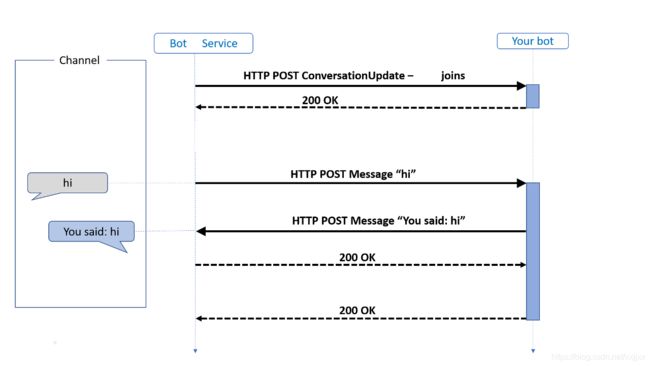Teams Bot开发系列:初识Bot
上次我们讲了Teams Bot开发的概述,讲了Azure Bot Service,Bot Framework SDK和我们自己的bot服务的概念,这篇文章就带大家看看Azure Bot Service和我们的bot是如何发生关系的。
我们自己开发的bot服务实际上就是一个api service,需要提供一个支持 POST 请求的endpoint。然后把这个endpoint的url注册到Azure Bot Service,这样当有人和你的bot进行聊天的时候,这个endpoint就会被Azure Bot Service所调用。
我们来看一个简单例子:用户在模拟器里对bot发送一个”hi”消息,然后bot回复一个”You said: hi”消息。整个流程如下:
- 当用户准备开始和bot进行聊天的时候,azure bot service就会向我们的bot endpoint上 POST 一个关于 conversationUpdate 的HTTP请求,告诉我们的bot,有一个用户准备要和bot聊天了。下面是Bot Emulator,相当于Azure Bot Service传递给我们bot endpoint的http request body
{
"channelId": "emulator",
"conversation": {
"id": "5d2a6fa0-a8c4-11ea-9482-fbaa8563d339|livechat"
},
"from": {
"id": "f2dc881f-5c55-4f44-a50a-0ecdb4717950",
"name": "User",
"role": "user"
},
"id": "5d354510-a8c4-11ea-9482-fbaa8563d339",
"localTimestamp": "2020-06-07T23:39:51+10:00",
"locale": "en-US",
"membersAdded": [
{
"id": "5d2a4890-a8c4-11ea-9762-2d13acd3a3d5",
"name": "Bot"
},
{
"id": "f2dc881f-5c55-4f44-a50a-0ecdb4717950",
"name": "User"
}
],
"membersRemoved": [],
"recipient": {
"id": "5d2a4890-a8c4-11ea-9762-2d13acd3a3d5",
"name": "Bot",
"role": "bot"
},
"serviceUrl": "https://762eb0b511e7.ngrok.io",
"timestamp": "2020-06-07T13:39:51.905Z",
"type": "conversationUpdate"
}
可以看到channelId说明是用模拟器聊天平台发出来的信息,from用户,type是conversationUpdate,具体内容是有两个新增加的成员(membersAdded),分别是User和Bot。大家需要注意一个conversation id,这个id是针对这次对话的,这次对话里可以你一句,我一句,每一句的id不同,但是他们的conversation id是一样的。
- 当用户发送一个 “hi” 文字内容给bot,这时候我们的bot endpoint会收到另一个POST 请求,内容如下:
{
"channelData": {
"clientActivityID": "1591537203426cjob1jjckwm",
"clientTimestamp": "2020-06-07T13:40:03.426Z"
},
"channelId": "emulator",
"conversation": {
"id": "5d2a6fa0-a8c4-11ea-9482-fbaa8563d339|livechat"
},
"entities": [
{
"requiresBotState": true,
"supportsListening": true,
"supportsTts": true,
"type": "ClientCapabilities"
}
],
"from": {
"id": "f2dc881f-5c55-4f44-a50a-0ecdb4717950",
"name": "User",
"role": "user"
},
"id": "6414c2c0-a8c4-11ea-9482-fbaa8563d339",
"localTimestamp": "2020-06-07T23:40:03+10:00",
"locale": "en-US",
"recipient": {
"id": "5d2a4890-a8c4-11ea-9762-2d13acd3a3d5",
"name": "Bot",
"role": "bot"
},
"serviceUrl": "https://762eb0b511e7.ngrok.io",
"text": "hi",
"textFormat": "plain",
"timestamp": "2020-06-07T13:40:03.436Z",
"type": "message"
}
可以看到这此的type是message,说明是一条消息,消息文字格式是纯文本plain,文字内容text是hi。
对照我们上面的conversation id,是不是发现这条的conversation id是一样的,说明这条消息和上一条是在同一个对话里进行的。
这里有一个serviceUrl,这个是我们Azure bot service模拟器的url,如果你的bot要回复用户一条消息,那这个消息就是发送到这个url上。
- 我们的bot收到上面这条用户发来的消息后,回复用户一条”You said: hi”的文字消息,bot就组建一个http request,POST 到上面这个service Url上,请求的body也是json格式,内容如下:
{
"attachments": [],
"channelId": "emulator",
"conversation": {
"id": "5d2a6fa0-a8c4-11ea-9482-fbaa8563d339|livechat"
},
"entities": [],
"from": {
"id": "5d2a4890-a8c4-11ea-9762-2d13acd3a3d5",
"name": "Bot",
"role": "bot"
},
"id": "6504a100-a8c4-11ea-9482-fbaa8563d339",
"inputHint": "acceptingInput",
"localTimestamp": "2020-06-07T23:40:05+10:00",
"locale": "en-US",
"recipient": {
"id": "f2dc881f-5c55-4f44-a50a-0ecdb4717950",
"role": "user"
},
"replyToId": "6414c2c0-a8c4-11ea-9482-fbaa8563d339",
"serviceUrl": "https://762eb0b511e7.ngrok.io",
"speak": "You said: hi",
"text": "You said: hi",
"timestamp": "2020-06-07T13:40:05.008Z",
"type": "message"
}
可以看到conversation id没有变化,需要注意的是replyToId,它表示bot回复的”You said: hi”,是针对用户前面发的那条”hi”消息的回复。所以这个replyToId的值就是前面那个消息的id。
大家看了这个流程了对应的json,是不是对bot的运作有一个具体的感觉了? :D
